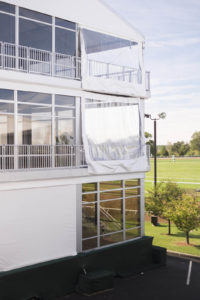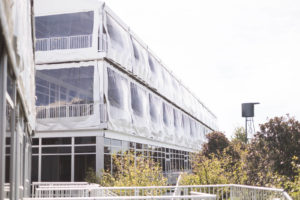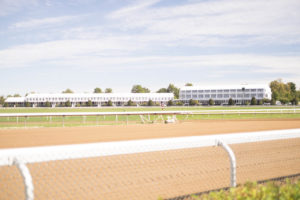
A play-by-play of how Shaffer Sports and Events designed, built and installed a triple-decker structure.
Faced with the dilemma of how to accommodate more hospitality suites at the Breeders’ Cup World Championships when all available ground space was already taken led Shawn Smith to think like an urban planner: Go vertical.
“What if we did a triple-decker?” the operations manager for Shaffer Sports and Events asked.
“Do you have one?” his client responded.
Conception
Based in Irondale, Ala., Shaffer Sports is an event rental company specializing in temporary structures for sporting events and has been installing double-decker tents for years. But triple-deckers are foreign to American soil. So Smith looked into renting one from a European supplier and returning it after the Oct. 30-31 horse race in Lexington, Ky. He quoted a price to his client, who replied, “It’s a little high, but it is in the range.”
Then Smith had another idea; this one he took straight to his boss.
“I said, ‘If I could build a triple-decker, we would have it from here on.’ We needed more double-deckers next year, so it would satisfy two needs,” he says, referring to the ability of triple-decker parts to be used in double-decker configurations.
Because the event contractor had a history with Shaffer Sports, it agreed to be something of a guinea pig—hosting an innovative triple-decker tent, made by a company that had never made one before.
Not only would having a tent built domestically cost less, but also it would avoid “the danger of bringing one over [from Europe] and something happening—it gets held up in customs or a container doesn’t make it,” Smith says.

Design
On March 21, he sat down with Shaffer Sports’ draftsman/designer in Virginia through web conferencing to start designing a three-level structure. He makes it sound simple.
“It’s modular. The first and second floors are platforms. The top is a standard A-frame building,” he says. The design resulted in a 65-by-20-meter tent with a 3-meter walkway on the back.
“We took extrusions that we produced for other tents and knew what size it would take to do a triple-decker. Then we got the engineer involved,” Smith says, referring to an engineering firm with which Shaffer often consults.
While extrusions were being made, Smith and the draftsman finalized the design of floor parts and brackets.
For the Breeders’ Cup, the tent would be 4 feet off the ground. The first two floors would each rise another 12 feet; and the top floor would add 10 more feet on the eaves, with the peak another eight feet up, for a total height of 46 feet above ground.
A triple-decker, of course, requires more stairs and lifts to meet egress codes, but Shaffer Sports had enough stairs to accommodate the build, and it rented chair lifts.
Installation
There was no time for a prototype. On July 1, the Shaffer crew began installing flooring.
“We held back on some things, like fabric,” Smith says. “We could get the floor and frame up and then go in and finish drawings for the fabric.”
Additional steel plates were required for the foundation, and glass walls for existing tents had to be modified with extra brackets. “Every base plate sits on a heavy scaffold system,” Smith says. “There are nine points of contact under each leg; usually you have one. You put a 250-pound steel plate on top of that.”

Cups—four on each corner of the scaffolding to keep base plates square—were about 3/8 inches too tall and had to be sent back to be cut down. That was a $3,500 fix.
“We had other changes, and they all added up to about $25,000,” Smith says. “That’s nothing when you are talking about a $1 million-plus project, especially since we didn’t do a prototype. There were very few hiccups in the overall project.”
A complication arose when Smith learned they would be unable to stake the structure, which would be installed in a parking lot.
“I told the engineer I had 4,000-pound blocks of concrete,” he says. “He came back with a configuration that called for using 175 blocks, for a total of 700,000 pounds of weighting.”
Calls from the field were inevitable. After all, it was the installation crew’s first experience with a triple-decker. Smith remembers that they would say, “You forgot to do [this],” to which he would reply, “No, you’re putting it in the wrong place.”
“That’s the learning curve: understanding the parts that go into this tent,” says Smith, who spent the first three weeks on-site and then returned for a couple of days every two weeks.
Future plans
About a month before the Breeders’ Cup, the conversation at Shaffer turned to the process and logistics of the teardown. The parts would be split up and sent to opposing coasts: to Florida for The Players Championship and to California for the Northern Trust Open golf tournament. The company also was in production for a 15-by-55-meter triple-decker with a 3-meter walkway for the Dell Match Play in Austin, Texas (with installation beginning Jan. 2 for the March event).
Smith credits The Players Championship—one for which Shaffer has been providing tenting since the late 1980s—as instigation for the triple-decker.
“We were going to be buying more double-deckers when we saw this opportunity,” he says, noting that the idea was to design the triple-decker to also use its parts in double-decker configurations. “By January 2016, we will have 125 meters worth of triple-decker product.”
For the Breeders’ Cup, the structure was divided into 18 hospitality suites.
The first floor, from which guests could exit to watch the race from the rail, was enclosed in glass. The second and third levels had 5-meter balconies where guests could stand at rails incorporated into the structure. While the floors will typically be tiered for future events such as golf tournaments, the triple-decker’s debut had a flat floor.
“The Breeders’ Cup is only a two-minute race,” Smith says. “They walk out to the rail for the race and then go back and party some more.”
And when the event concluded, there was little doubt that Smith and his colleagues would have reason to party as well.
[ Janice Kleinschmidt is a freelance writer based in San Diego, Calif. ]
 TEXTILES.ORG
TEXTILES.ORG


